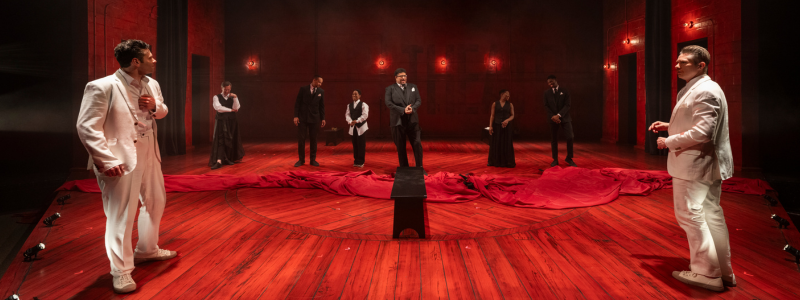Post-Show Discussion Activity

Dive into deeper reflection with companions, classmates, or yourself after your viewing of Tom Stoppard’s Rosencrantz and Guildenstern Are Dead.
If engaging in this activity independently, consider taking notes or writing your reflections down. If engaging in this activity with a class or group, decide if you would like to answer every question in order, skip around, or select certain questions to spend time on.
Discussion Questions
- Rosencrantz and Guildenstern are simultaneously everywhere and nowhere—and yet, emblazoned on the back wall of the set, are the words “Court Theatre.” What do you make of Court Theatre as a location, or even a character, within this production?
- How do you make sense—existentially or literally—of the Ensemble? Who are they? What is their role?
- Rosencrantz and Guildenstern is a play in which neither the characters nor the audience feels much groundedness or certainty. How do the characters’ experiences of confusion compare or contrast with your own experiences of being disoriented or lost?
- Rosencrantz and Guildenstern are constantly trying to riddle out the same questions asked by existentialism: Who am I, Where am I, Why am I here? How do you understand the answers (or lack thereof) to these questions by the end of the play?
- Court Theatre’s production makes careful use of shapes and shadows—to what effect?
- Rosencrantz says in Act II, “We have no control – none at all.” To what extent do you find this to be true in the world of the play? What about in our own world?
- At various points in the show, Rosencrantz and Guildenstern mix up who is who. What meaning does this blending, or confusion of characters, hold?
- If you are familiar with Hamlet, how does this production lend itself to new insights of Shakespeare’s play? If you are unfamiliar with Hamlet, how do you make sense of the play within the play?
- How do we learn what our own needs are? How do we learn how to meet those needs? How do Rosencrantz and Guildenstern approach this conundrum?
- This activity aligns with the following standards:
- Illinois Arts Learning Standards
- Anchor Standard 7: Perceive and analyze artistic work.
- Anchor Standard 8: Construct meaningful interpretations of artistic work.
- Anchor Standard 11: Relate artistic ideas and works with societal, cultural, and historical context to deepen understanding.
- Common Core State Standards
- CCSS.ELA.SL.1 Prepare for and participate effectively in a range of conversations and collaborations with diverse partners, building on others’ ideas and expressing their own clearly and persuasively.
- CCSS.ELA.R.3 Analyze how and why individuals, events, and ideas develop and interact over the course of a text.
- Illinois Arts Learning Standards